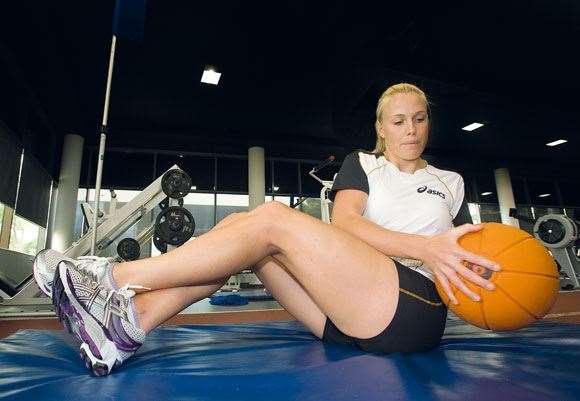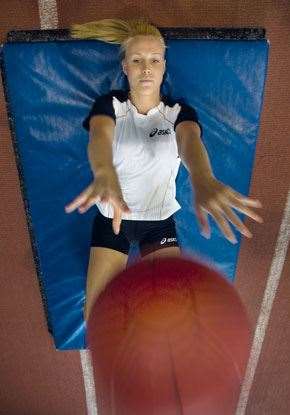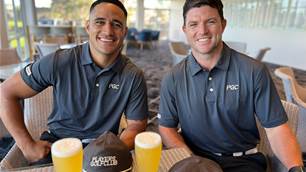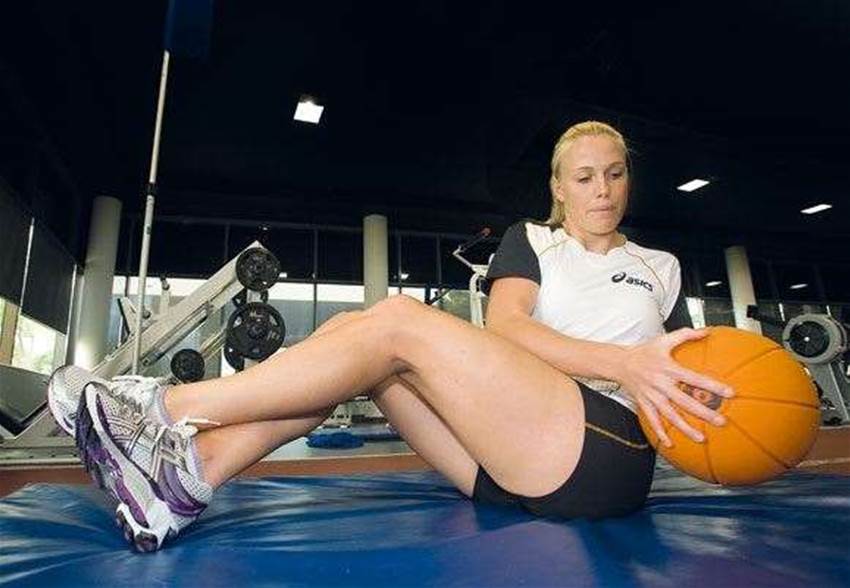Over the off-season the girls have been sweating out the nightmares of ’09. Here, powerhouse centre Kimberlee Green reveals the regime that aims to drag the Swifts back to the peak of the ANZ
Over the off-season the girls have been sweating out the nightmares of ’09. Here, powerhouse centre Kimberlee Green reveals the regime that aims to drag the Swifts back to the peak of the ANZ
 Getting drilled
Getting drilledThe “premiership hangover” is a peculiar phenomenon generally attached to boofheaded footy players. But don’t think girls are immune … Back in ’08, the inaugural year of the ANZ Championship, the NSW Swifts swept all before them. They finished the regular season with ten wins and a mountain of goals. In the major semi they travelled to Hamilton and edged the Waikato Magic by a single goal. Come the final there was an air of inevitability; 12,000 Sydneysiders flocked to Acer Arena to watch the Swifts demolish the Magic by nine goals. Stocked with talent and coursing with confidence, the Swifts looked to be building a long and regal dynasty.
Then the wheels fell off. In their second year the Swifts couldn’t string a pair of wins together. Luck deserted them: they lost two games in extra time, lost three other games by a single goal. Form deserted them: in round three the Magic topped them by 18 goals, in round 11 the Vixens topped them by 11. The mighty had fallen. They finished the season with just two wins to their credit.Don’t expect a repeat performance this year. Over the off-season the girls have been sweating out the nightmares of ’09. Here, powerhouse centre Kimberlee Green reveals the regime that aims to drag the Swifts back to the peak of the ANZ
Fast feet
“Before we head to the gym, we normally do a sprint session. We start off very short – sprinting over two metres, four metres, six metres. We do these from a normal standing start – it’s all about quick turnover in the legs. In netball you often don’t have time to set up a good starting position before you run, so with these sprints we work on starting from a variety of different positions. We also do a drill called rolling backs, where we jog backwards, our trainer calls go, and we’ll have to explode out of the jog into a short sprint. It’s very much a reactive drill. The trainer also mixes it up; for example sometimes he’ll call jump and we’ll have
to jump before exploding into the sprint.“After that we normally do a drill called five-ten-five, where you have to run to your right for five metres, push off, run to your left for ten metres, push off, then run back to your right for five metres. During the season we’ll normally add to these drills – for example we’ll lay a rope ladder on the floor and have to run over it, our feet landing in the spaces, the emphasis on fast, light feet.”
Practical strength
“Recently we’ve had a few back problems in the squad so we’ve started a new regime for our core strength called physiocise.
It’s all about doing un-weighted exercises that work your gluts and quads, but also force you to switch on your core as you
do them. There’s a lot of static squats, where you’re resting against a wall, a lot of lunges and a lot of floor work where we work some movement into the back. It’s all about using the right muscles – your core, gluts, hammies – to control the movement and hold your posture. We do physiocise before we go into a weights session and it normally lasts for 45 minutes – a definite leg burner!“We also do a lot of bridging on Swiss balls. For example we’ll lie on our backs, place our feet on the ball, then lift our bums up so we form a plank. Again, it hits the hammies, gluts and core. Occasionally we use weight plates in our core work. ‘Russian twists’ are a good one – we hold a sit-up position, our feet off the ground, holding a ten-kilo plate in front of us, and then twist from side to side. We also use sandbags to add a practical element in our core work. We lie flat on the floor with a sandbag weighing ten kilos on our shoulders, and then we have to get up to a standing position using just the one hand while holding the sandbag on our shoulder. Again, the focus is on maintaining complete composure through the core as you’re doing a certain movement.”
 Power play Images: Warren Clarke
Power play Images: Warren ClarkePower play
“The make-up of our personal gym program depends on our weaknesses or needs. Personally, I’m a power player; even though I play centre and run quite a bit during a game, I’m an explosive centre as opposed to a long-running centre, so the gym work I do is strength-based with a fair bit of power popped in.“We start with a warm-up – light calf raises and very light dumbbell movements to warm our arms. After that we move into squats. We’ll start with a heavy box squat [lowering onto a box then pushing off from the seated position], then do a power jump set in between the squats – that way we build both strength and power. The box squat is good because you get good depth on the movement, but you also have to display control moving up and down.
“For the power set we jump up onto a medium-sized box, say 60cm high. We hold a dumbbell in each hand and then release it at the lowest point of the jump. It’s called a ‘release jump’ – it’s similar to a jump squat – and it’s great for explosive power. The reps obviously change at different points of the season, but at the moment, heading into the season, we’re doing four sets of five reps on both the squats and power sets.“Staying on our legs, we also do a lot of static lunges with the bar held across our shoulders. At the moment we’re working eight reps on each leg for four sets. In between the lunge sets we do an exercise called Nordic lowering, where you kneel down, secure your feet against a wall, then lean as far forward as you can. It really hits the hammies and gluts.“At the moment we’re not doing a lot of upper body work – we normally don’t target our upper bodies until we really get into our on-court work. In-season we’d be doing a lot of bench press and bench pull, using quite a heavy load. As with the legs, in between those heavy bench sets we’d move into a power set. A common power exercise is to lie on your back, holding a medicine ball on your chest, and throw the ball as high in the air as you can. We normally start our upper body work a month or two out from the start of the season.”
En court!
“We always start a court session with a dynamic warm-up – a lot of running, sliding, skipping; basically any movement to get the body warm. We don’t do a lot of static stretching, instead we’ll incorporate movement into the stretches. So, for example, we’ll walk three steps, stretch our left hamstring, walk three steps, stretch our right hamstring … From there we’ll go into some one-on-one ball work where we pair up and go through the motions we’ll use on court – chest passes, shoulder passes, etc.“After that we go into some game-specific agility work. During the pre-season this agility work has a heavy fitness emphasis. We’ll have, say, five sequences of different coloured cones lined out, and we’ll get into pairs and run through the sequences. Within these sequences there are around five typical movements – clearing around a cone, breaking left, breaking right, etc – with passing thrown in. All the cones are colour coded – just makes it a bit easier to follow. It’s one-on, one-off; your recovery is the time it takes your partner to do the sequence, so it’s not much of a break. We normally do around five sets of these sequences.”
Getting drilled
“During the pre-season we work continuous drills in 15-minute blocks. This gets our match fitness up, gets us used to playing in 15-minute blocks (games are divided into 15-minute quarters). We’ll work these drills in the middle third of the court, the squad divided up into four groups, each group lined up at the corners of the square.“From here, the drills are generally pretty simple. For example, you face the group diagonally opposite you, run towards them, receive a pass on your right-hand side, then off-load that ball to the person you’re running towards. Essentially it’s a crossover drill. It’s all about running the right lines, placing the ball perfectly, knowing who you’re passing the ball to, knowing how far they can reach … After each run we’ll normally get a five-second rest and we’ll just run that drill over and over for 15 minutes. The lactic acid builds very quickly, so we have to push through that. It’s great for honing match fitness.“After that the squad will break up and we’ll all work on our specific games. I’ll go to the mid-court and work a lot of reactive balls around the circle. Of course, in netball, the mid-courters can’t go in the circle, so we do a lot of work driving onto the circle, particularly the top of the circle directly in line with the post. I’ll work at driving toward that spot, then receiving a lot of sharp reactive passes on the edge of the circle. That’s essentially the basis of mid-court work – receiving and placing balls around that circle without going off-side.“After that we’ll bring the squad together. In most training sessions there’s a specific structure we’ve been working on, so we all know what the other groups – the shooters, the defenders – have been focussing on. This makes our game-situation training much tougher and generally forces us to put some personal finesse into our play. The games are normally half-court, the attackers bringing the ball down court, the defenders trying to intercept it and take it back to the halfway line, just like a half-court basketball game.”
 Kimberlee green Portrait Images: Warren Clarke
Kimberlee green Portrait Images: Warren ClarkeCold healing
“We normally finish a session with some static stretching. They’ve done tests and found that after a heavy session static stretching is the best way to recover because your muscles are already broken up from the exercise – you don’t want to damage the muscles further by doing dynamic stretching. After the stretching it’s straight into the cold plunge pool, up to our chests, for a minimum of five minutes. If we’re really sore we might stay in a little longer. I normally stay in around six minutes – any longer than that and I freeze! The pool we use is pretty small, so we can’t really run or walk in it, but when we’re down at the AIS the pools are massive so we get a bit of light, weight-bearing movement into our recovery.”
Joint pain
“All the girls strap their ankles for every court session, every game. It’s something we’ve done all the way through, ever since we were juniors. I’m not sure if any research has been done into the effectiveness of strapping, but for us it’s a precautionary thing. It’s interesting, though, that the New Zealanders, for example, never strap. They have no protection – I’m not sure why.
“We don’t normally strap knees unless someone has had a previous problem, a reconstruction, for example. I find if the muscles around my knee are working properly, then I should have no problem, but if one of the muscles is tight, then my knee will feel it. It’s just a matter of knowing your own body and knowing what works for you. I find that if my gluts aren’t doing the right thing, then my ITB (iliotibial band) gets tight and pulls my kneecap across – I feel a pulling sensation in my knee. So when I feel that pulling, I tape two tennis balls together and then roll them along my ITB, loosening the muscles either side of the band.”
Screen games
“Before each court session we’ll normally sit down as a team and watch a compiled video of things we need to work on for that session. This is normally a short session – no longer than ten minutes.“At the moment we’re also doing a lot of individual video analysis – our assistant coach has been cutting up video of specific things that each individual needs to work on, and then he pops that footage on our iPods. At the moment, for example, I’m focussing on my work as a defensive centre, trying to block up my opposite number after they’ve passed the ball ratherthan just running down the court with them, letting them have that long run out of defence. [This makes me sound really lazy!] Attack-wise, I’m also studying our team structure, which is going to be important this year given we’re such a new team. Our assistant coach has dumped a massive amount of video on my iPod for me to watch … But I do find video analysis really helpful; I find it very easy to recognise flaws on the court after I’ve seen them from different angles on the video.”
– Aaron Scott
Related Articles

Viva Las Vegas: Join Golf Australia magazine's Matt Cleary on a golf and rugby league spectacular

19 Holes With ... Chad Townsend and Val Holmes







.jpg&h=115&w=225&c=1&s=1)





